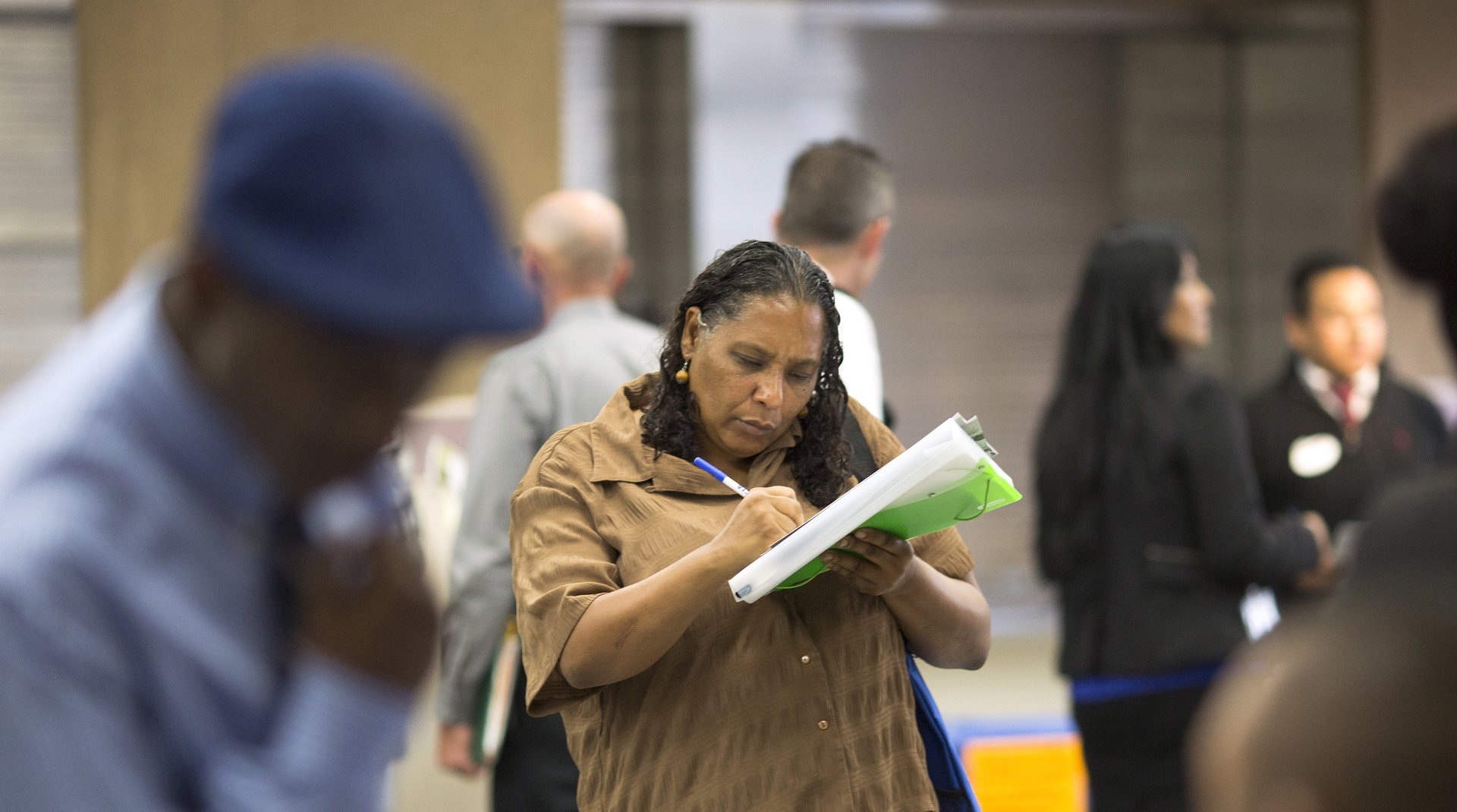Long-term unemployment is one of the most pernicious effects of the Great Recession
This story is part of a series addressing a central question: “How Can We Accelerate Social Mobility in America?” The authors are participating in the 2016 meeting of Clinton Global Initiative (CGI) America (June 12-14 in Atlanta), where leaders in business, philanthropy, government, and nonprofits are turning ideas into actions that help strengthen the US economy.


This story is part of a series addressing a central question: “How Can We Accelerate Social Mobility in America?” The authors are participating in the 2016 meeting of Clinton Global Initiative (CGI) America (June 12-14 in Atlanta), where leaders in business, philanthropy, government, and nonprofits are turning ideas into actions that help strengthen the US economy.
The persistence of long-term unemployment is one of the most pernicious and enduring effects of the Great Recession—and one at serious risk of being overlooked.
While the US economy has substantially recovered and the overall unemployment rate has fallen sharply, the percentage of the unemployed who have been out of work for more than six months is still approximately one in four job seekers—levels unseen in the United States since the nation’s worst previous recession in the early 1980s. What we need is to recognize the severity of the nation’s long-term unemployment problem, raise awareness especially with employers and policy makers, and develop and support new cost-effective tools and programs to make it possible for struggling job seekers to reconnect to employment.
Lingering long-term unemployment wreaks havoc on social mobility. Described as a “cancer in the job market,” long-term unemployment has devastating consequences for individuals, families, and communities. The long-term unemployed are five times more likely to be living in poverty than employed individuals. Further, there is evidence that even when the long-term unemployed do find new jobs, they often earn far less than they were earning previously, and take a step down the career ladder. Other research has found that not only is within-career mobility affected by long-term unemployment, across-generation mobility suffers as well, starting with evidence that the children of those who lose jobs have poorer academic performance.
Long-term unemployment also afflicts a wide swath of the labor force—including college graduates. A person with a bachelor’s degree or higher is only slightly less likely to be among the long-term unemployed than a person with less than a high school diploma. However, several demographic groups, including blacks, Asians, and older workers, are more likely to experience long spells of joblessness.
The results of this unemployment include isolation, stress, anxiety, and depression. Being jobless for months or even years can permanently alter individuals’ personalities, and lead to higher mortality rates and declining life expectancy. Joblessness also increases the incidence of alcohol, drug abuse, and even suicide.
Regrettably, the under-resourced public workforce system is not providing sufficient services to combat this terrible condition. During the depth of the Great Recession, nearly two-thirds of unemployed workers received up to 99 weeks of Unemployment Insurance. Those benefits were eliminated in 2013. Now, qualified unemployed workers receive no more than 26 weeks of aid.
According to the Heldrich Center’s surveys of the long-term unemployed, almost half of those who did obtain Unemployment Insurance ran out of benefits before they were able to find work. The vast majority of those who were laid off during and after the recession reported that they received no other form of government assistance. In 2013, less than 1 in 10 of the long-term unemployed received help from a government agency when they were looking for a job. Less than 1 in 20 were enrolled in a government-funded training program to prepare for new job opportunities.
Compounding the lack of government aid is the fact that many employers are reluctant to hire the long-term unemployed even when they have the requisite skills and experience. In addition to suffering from the stigma of long-term unemployment, older workers, who are overrepresented among the long-term unemployed, often experience age discrimination. Because many older job seekers have not looked for work in decades, they are unfamiliar with contemporary job search techniques and need advice about the best ways to restart their careers.
In the past few years, several initiatives to assist long-term unemployed individuals have gotten under way. The US Department of Labor is supporting efforts in 23 communities to provide training and other resources through its $170 million Ready to Work grants. The AARP Foundation is providing assistance to older, long-term unemployed job seekers through its Back to Work 50+ program. In late 2015, responding to the high long-term unemployment rates plaguing New Jersey, Rutgers University’s Heldrich Center for Workforce Development launched a statewide effort called the New Start Career Network (NSCN) to assist long-term unemployed, older workers.
NSCN is currently providing free-of-charge services to over 900 older, long-term unemployed workers, including information and advice about the labor market and job search strategies via a website (newstartcareernetwork.org) and group tutorials, one-on-one coaching from over 140 trained volunteers, and access to a broad range of services through over 25 nonprofit, government, and employer partners, including education, training, mental health counseling, and incentives to encourage employers to offer trial employment and on-the-job training.
In June 2016, the Heldrich Center announced plans to greatly expand NSCN, in partnership with the Philip and Tammy Murphy Foundation and more than 25 other organizations, in a Commitment to Action at the Clinton Global Initiative (CGI) America. Through the CGI commitment, NSCN will be well positioned to engage with new partners that can help in its plans to assist 9,000 long-term unemployed workers by the end of 2019. After all, no institution can take on such an entrenched and complex problem alone.